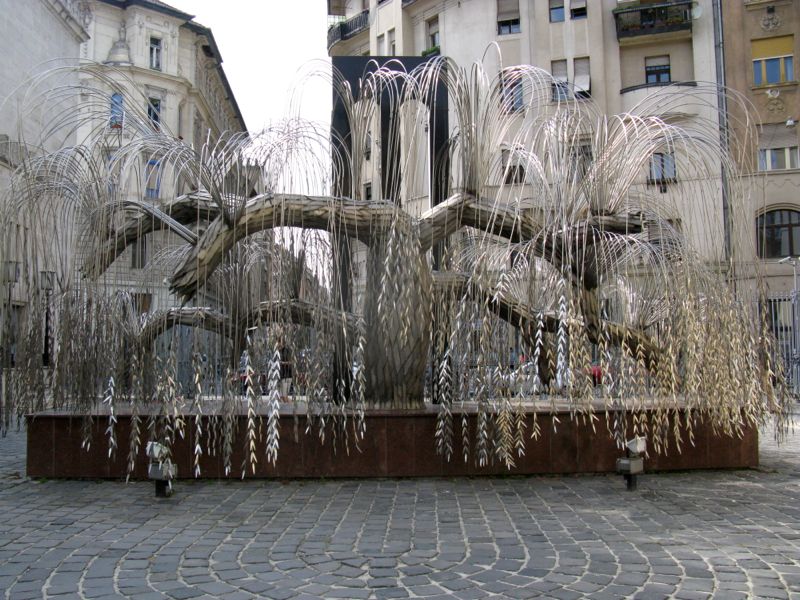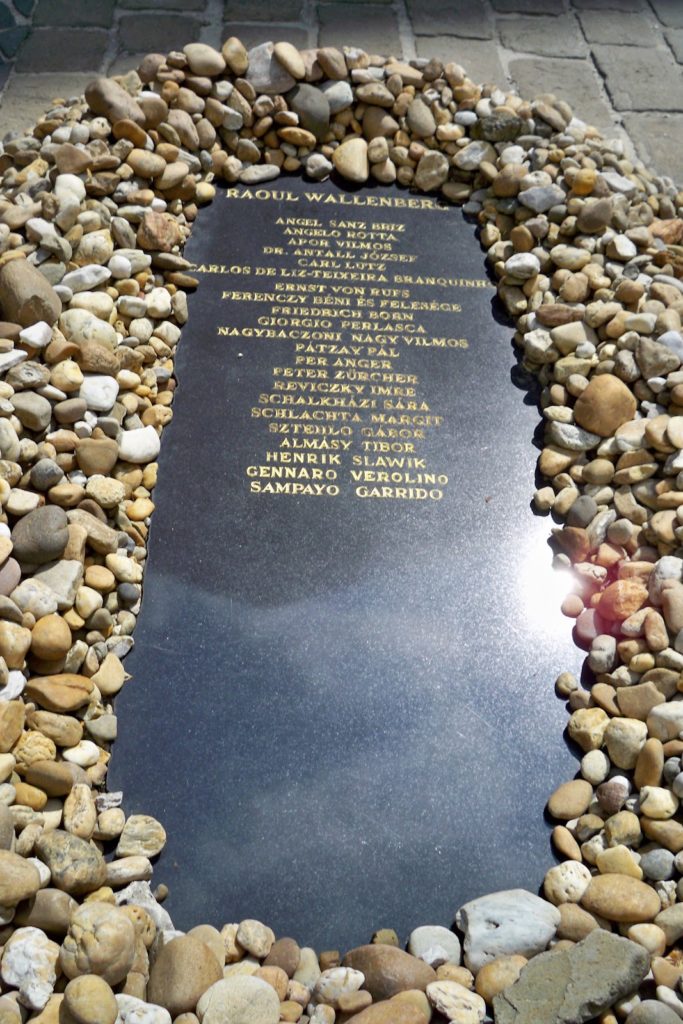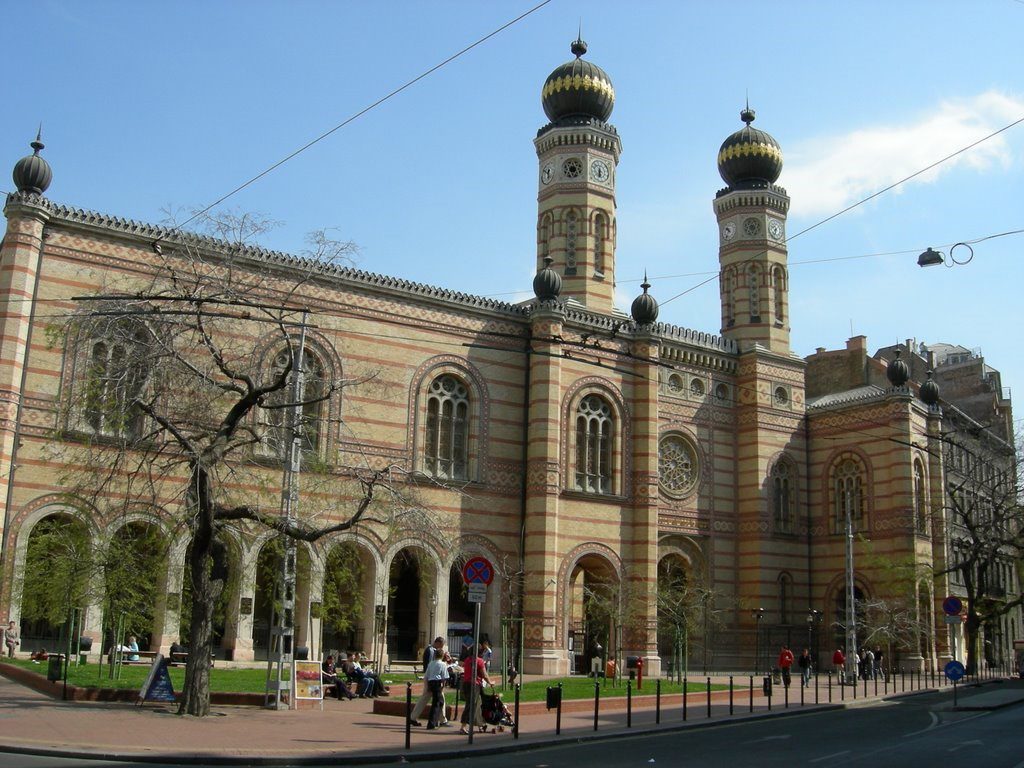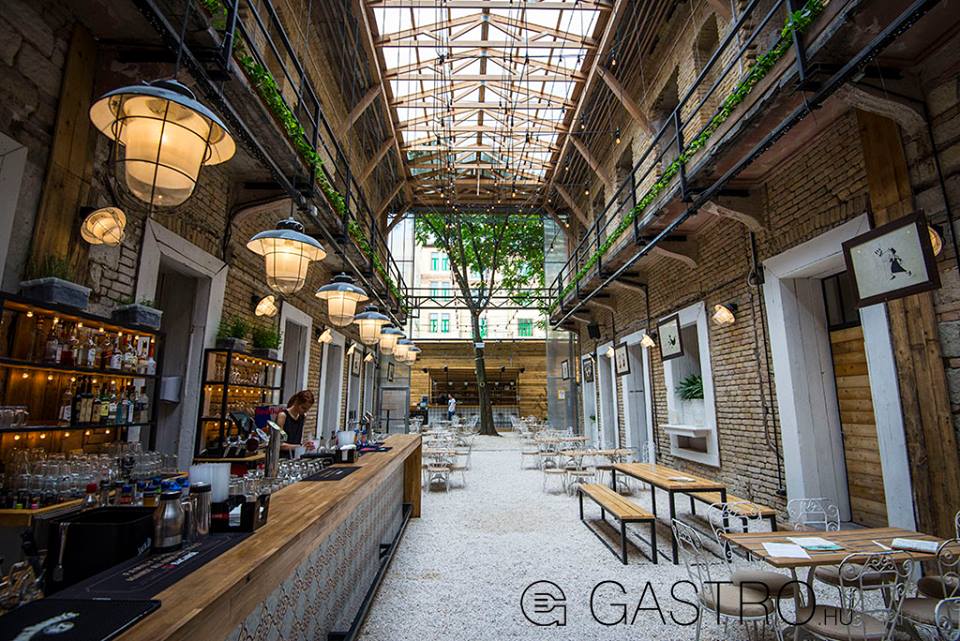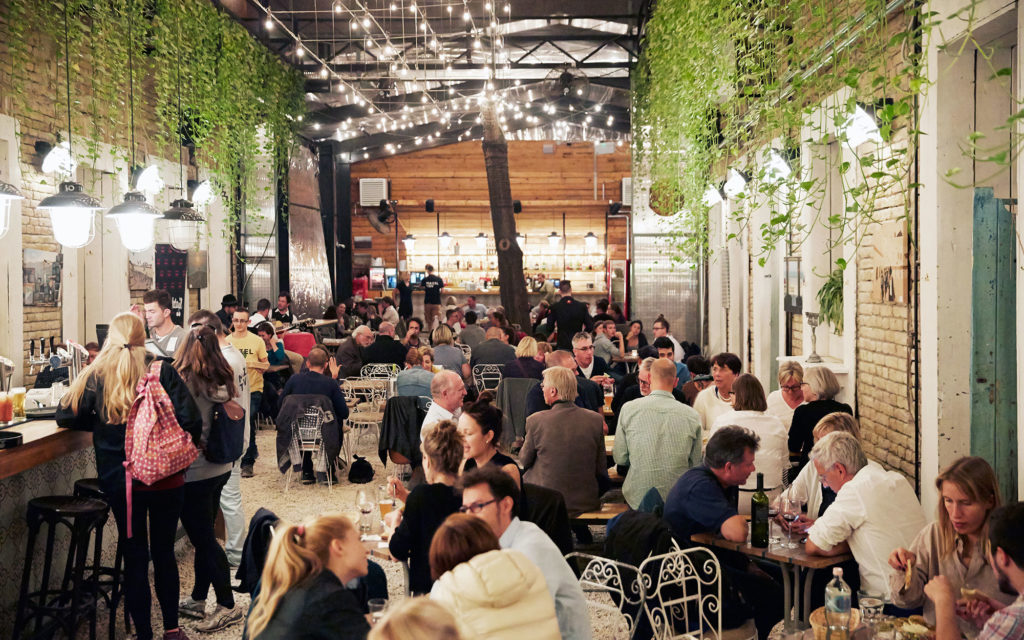Walking along Wesselényi Street, thinking we were still headed toward the restaurant, we passed a series of markers honoring famous Jewish Hungarians including such familiar names as József Pulitzer and Erik Weisz who may be better known to you by his stage name – Harry Houdini. We approached the synagogue complex from behind and passed a small cemetery. This is noteworthy because Jewish cemeteries are rarely in proximity to synagogues. It’s likely that historical circumstances contributed to its placement. As it turns out, the cemetery might be physically small but it is crowded and, I later learned, contains many mass graves.
We next came upon the edge of Raoul Wallenberg Emlékpark (or Memory Park) which is also part of the Dohány Street complex. Wallenberg, you probably know, was a Swedish diplomat who, while serving as his country’s special envoy in Budapest, sheltered Jews in buildings considered Swedish territory and issued thousands of protective passports to assist Jews fleeing the Holocaust. He’s credited with saving tens of thousands of lives. (Wallenberg is among the most recognizable names of non-Jews who rescued Jews during the Holocaust. You might also think of Oskar Schindler whose renown grew after Steven Spielberg’s film.)
Walking by this park, we passed the Memorial of the Hungarian Jewish Martyrs which is also known as the Tree of Life.
The leaves on the weeping willow like memorial bear inscriptions with the names of victims. Remember that upwards of 400,000 Hungarian Jews died in the Holocaust so leaves are continually added – often by surviving family members.
Wallenberg’s fate took a dark turn when on 29 October forces of the Soviet Union launched an assault on Budapest. They had completely encircled the city by 26 December. On 17 January 1945, Marshal Rodion Malinovsky, the commander of the Second Ukrainian Front, ordered Wallenberg to his headquarters. This marks the date of Wallenberg’s disappearance. In 1957, the Soviets released documents indicating that Wallenberg had died or been executed (many contemporaneous documents contradict one another) in Lubyanka Prison in 1947. Claims that Wallenberg had not died arose as early as 1949 and continued into the sixties and early seventies.
Whatever his fate, Wallenberg’s body has never been discovered and he has no formal grave. The Budapest park bearing his name symbolically remedies that.
The other names inscribed include more people who lived in Budapest at the time and who are known to have taken affirmative steps to save Hungarian Jews. They are considered to be among the Righteous Among the Nations – an honorific applied by the state of Israel to non-Jews who risked their lives to save Jews during the Holocaust.
We turned the corner to face the front of the restored synagogue which was originally built between 1854 and 1859 in a Moorish Revival style. The building was bombed by members of the Arrow Cross Party in 1939 and was severely damaged by air raids during the Soviet siege. While its repair and restoration didn’t begin until 1991, some of the few remaining Hungarian Jews were able to use it as a house of prayer during the Communist era.
The two onion dome towers rise to a height of 43 meters.
Mazel Tov! Literally and figuratively
At some point, we figured out that we hawed when we should have geed and turned our figurative horse in the proper direction to find Mazel Tov.
When you read about Budapest nightlife, you will undoubtedly come across the term ruin pubs or sometimes ruin bars. The Hungarian word is romkocsma which is simply a compound of the words rom (ruin) and kocsma (pub). These places began to spring up in the early part of this century beginning with a bar called Szimpla kert or Simple Garden. The proprietor of a romkocsma starts by finding an abandoned building – preferably with an open-air interior or an adjoining vacant lot to hold some picnic tables and a few beer taps. Each ruin pub creates its own distinctive ambience and aura dictated in part by the owner’s choice of thrift-shop and patio décor and in part by the live music that is often a feature of these night spots. The BBC calls ruin pubs a cross between “a chill Berlin squat with a smallish Munich beer hall.”
Mazel Tov is among the newer ruin pubs that have played an essential role in the revitalization of the Jewish Quarter specifically and, more broadly, Budapest’s District VII.
(When the cities of Pest, Buda, and Óbuda officially merged in 1873, the new united city – perhaps drawing inspiration from Paris – was divided into 10 districts denoted by the Roman numerals I – X. Over time, the city has grown to 23 [or XXIII] districts. Four were added in the 1930s, and another nine on 1 January 1950 when Budapest annexed seven neighboring towns and 16 villages. There’s no obvious order to the numeric assignment. For example, Districts I, II, III, XI, XII and XXII are on the Buda side of the river and all but District XXII adjoin District I which is also known as the Castle District.)
Even when we found Akácfa Street, had we not been on the lookout for it,
we would have almost certainly walked past it. When we spotted it, we both shouted a hearty, Mazel tov!” (Mazel tov is the Yiddish expression meaning congratulations.)
Once you get through the dilapidated entrance, it looks like this:
But in truth, when Pat and I got there, it looked more like this:
We asked for a table for dinner but the hostess told us that the few open tables we saw had been reserved. However, she then told us that if we could finish by either 20:00 or 20:30 (I don’t recall the specified time) she’d seat us. A little tired and more than a little hungry, we agreed to do that.
The restaurant features Middle Eastern cuisine and both Pat and I had a dish of lentil soup that was so delicious it prompted me to email the restaurant (alas, unsuccessfully) to request the recipe. As we’ve stayed in contact via email since our return to the States, Pat reminded me that we followed the soup with chicken shawarma that’s served with falafel and hummus. I’m sure the shawarma was tasty but I honestly didn’t remember the main course. That lentil soup on the other hand… I think I also had a small draft Staropramen unfiltered wheat beer but I could be conflating different dinners.
Of course, given that we were in Europe, where asking diners to rush a meal is generally not done, Pat and I were able to sit for quite some time after we finished eating and enjoy the live and recorded entertainment. The live part was a saxophone player set up in a corner just steps from our table and the recorded part was the “band” streaming from his I-pod that accompanied him. After a while, we began, in our all too American way, to feel a bit guilty for violating the time limit we’d agreed on and one of us accosted our server (okay, maybe accosted is a bit strong) to request the check. She not only brought it at her own pace but returned for our payment (cash only) at her own leisurely pace.
The sun had set before we left but by this point, the impeccable facet of my directional sense had imprinted on the proper synapses and we set off for the hotel reaching it without a single misstep.
Tomorrow we have a full day beginning with a walking tour of Budapest. Hope to see you then.
